Citation: Andrew A. Chien, Fan Yang, Chaojie Zhang. Characterizing curtailed and uneconomic renewable power in the mid-continent independent system operator[J]. AIMS Energy, 2018, 6(2): 376-401. doi: 10.3934/energy.2018.2.376
| [1] | Solomon A. A., Michel Child, Upeksha Caldera, Christian Breyer . Exploiting wind-solar resource complementarity to reduce energy storage need. AIMS Energy, 2020, 8(5): 749-770. doi: 10.3934/energy.2020.5.749 |
| [2] | Surender Reddy Salkuti . Sustainable energy technologies for emerging renewable energy and electric vehicles. AIMS Energy, 2024, 12(6): 1264-1270. doi: 10.3934/energy.2024057 |
| [3] | Yassine Charabi, Sabah Abdul-Wahab . The optimal sizing and performance assessment of a hybrid renewable energy system for a mini-gird in an exclave territory. AIMS Energy, 2020, 8(4): 669-685. doi: 10.3934/energy.2020.4.669 |
| [4] | Zeid Al Qaisi, Qais Alsafasfeh, Ahmad Harb . Stability impact of integrated small scale hybrid (PV/Wind) system with electric distribution network. AIMS Energy, 2018, 6(5): 832-845. doi: 10.3934/energy.2018.5.832 |
| [5] | Dalong Guo, Chi Zhou . Potential performance analysis and future trend prediction of electric vehicle with V2G/V2H/V2B capability. AIMS Energy, 2016, 4(2): 331-346. doi: 10.3934/energy.2016.2.331 |
| [6] | Foday Conteh, Shota Tobaru, Mohamed E. Lotfy, Atsushi Yona, Tomonobu Senjyu . An effective Load shedding technique for micro-grids using artificial neural network and adaptive neuro-fuzzy inference system. AIMS Energy, 2017, 5(5): 814-837. doi: 10.3934/energy.2017.5.814 |
| [7] | Rashid Al Badwawi, Mohammad Abusara, Tapas Mallick . Speed control of synchronous machine by changing duty cycle of DC/DC buck converter. AIMS Energy, 2015, 3(4): 728-739. doi: 10.3934/energy.2015.4.728 |
| [8] | D. Marene Larruskain, Inmaculada Zamora, Oihane Abarrategui, Garikoitz Buigues, Víctor Valverde, Araitz Iturregi . Adapting AC Lines to DC Grids for Large-Scale Renewable Power Transmission. AIMS Energy, 2014, 2(4): 385-398. doi: 10.3934/energy.2014.4.385 |
| [9] | Syed Sabir Hussain Rizvi, Krishna Teerth Chaturvedi, Mohan Lal Kolhe . A review on peak shaving techniques for smart grids. AIMS Energy, 2023, 11(4): 723-752. doi: 10.3934/energy.2023036 |
| [10] | Mohamed M. Abdelzaher, Almoataz Y. Abdelaziz, Hassan M. Mahmoud, Said F. Mekhamer, Samia G. Ali, Hassan H. Alhelou . Generation expansion planning with high shares of variable renewable energies. AIMS Energy, 2020, 8(2): 272-298. doi: 10.3934/energy.2020.2.272 |
Over the past two decades, a growing consensus on climate change due to anthropogenic carbon has emerged [1,2]. In response, there are growing worldwide efforts to reduce the amount of carbon being released into the atmosphere [3,4]. Ambitious "renewable portfolio standards" (RPS) goals for renewable power as a fraction of overall power have been widely adopted. Midwest examples from the Mid-continent Independent System Operator (MISO) system include Illinois (25% by 2025) to Minnesota (25−31% by 2025). California and New York have adopted a 50% goal by 2030 [5,6]. Obama's "Clean Power Plan, " (August 2015) [7], calls for a 32% national reduction in electric power carbon emissions by 2030, with renewables a critical element. The U.S. Department of Energy's landmark report, "Wind Vision 2015, " targets a United States 35% RPS for wind alone by 2050, with regions such as the Midwest and Texas at 50% wind RPS. A recent report, proposes 50% solar-only RPS scenario for California [8]. Any of these scenarios are a dramatic jump from the US's combined solar and wind RPS of 5.2% in 2014 [9]. These ambitious and transformative goals pose serious power grid challenges including ability to achieve "merit order", efficiency, stability, and resiliency.
Evidence of such challenges includes growing curtailment, uneconomic generation, and RPS stagnation. Curtailment, where the power grid is unable to accept renewable generation due to congestion, misforecast, or excess generation, causes power to be discarded at the generation site (Europe and the United States [10,11] and China [12]). Despite programs to increase transmission capacity and employ economic dispatch, curtailed power in Europe, United states, and China exceeds 50 TWH per year [12]. Economic dispatch has been deployed to reduce curtailment, providing economic incentives (payments) and disincentives (negative payments) for generation, but the result is uneconomic power generation, power purchased by the power grid at a negative price [13,14]. We use the term stranded power (SP) to describe both curtailed power and uneconomic generation as they together represent excess renewable power generation. As several regional power grids have reached RPS approaching and in some cases exceeding 30%, there is growing evidence that achieving RPS of 50% poses significant challenges in grid flexibility (RPS growth stalled [15]), growing stranded power [13,14,16,17,18,19,20], and grid reliability challenges. [17,21]. Recent studies examine not only increased curtailment, but also the lesser utility (capacity factor) of renewables as their fraction is increased [22,23]. All of these scenarios suggest that future grids will have much larger quantities of stranded power than today's.
Thus, to provide a basis for understanding and exploitation of stranded power, we undertake a detailed analysis of the dynamic properties of stranded power. Our objective is to provide insights into its current properties that might enable its exploitation for use or inspire new techniques that reduce its occurrence. To this end, we analyze 40 months of detailed records from the Midcontinent Independent System Operator (MISO) power grid market. These records include detailed temporal structure (5-minute intervals), potential generation (eco_max), actual accepted generation, and pricing. Based on analysis of this data, our specific contributions include:
● A detailed temporal characterization of stranded power in the MISO grid, showing it is available 99% of the time, and often in intervals with long duration (mean of 109 hours, stdev of 110 hour, and max of 816 hours). Significant quantity is is available, averaging over 1 GW and with duty factor 30% at that level. Significant daily (hours) and seasonal variation are documented.
● Study of a 3.5-year period that demonstrates the persistence of stranded power in the MISO grid of more than 6 TWh and up to 15 TWh per year.
● Considering stranded power locally, we find single-site stranded power can have duty factors as high as 70% and power levels as high as 250 MW. While the single sites with highest duty factor had average interval length of 0.93 hours, its distribution (stdev 8 hours, max 593 hours) enables a more usable duty factor of 40% drawn from intervals >5 hours. Those with highest quantity of stranded power can achieve duty factors >30% with intervals >1 hour and at significant power. Studies of top 10 sites demonstrate similar characteristics.
● Increasing stranded power usability with energy storage requires defining storage capacity and power as well as stranded power load. At 0.25 GW load, the first hour of storage increases duty factor to 82% (a 15% increase), but benefits decrease rapidly, with minimal benefits beyond 8 hours. At higher power levels, the achievable duty factor falls off significantly with 62% and 46% achievable for 1 GW and 2 GW respectively.
● Adding storage at carefully selected sites is productive. At the best 5 sites, adding 5 hours increases duty factor over 70% at 4 MW. Selective distribution to the best sites achieves 2 to 3.7x greater benefit than uniform distribution. However, attaining 100% duty is difficult. At a 4 MW power level, 50 hours is sufficient for only 3 wind sites to reach 100% duty, and 250-1000 hours required at higher power levels.
The rest of the paper is organized as follows. In Section 2 we briefly summarize realities of the modern power grid -power markets, grid dispatch, and the incorporation of variable renewable generation. Section 3 we define stranded power, and characterize it within the MISO grid. A common proposal is to use energy storage to increase the utility of stranded power; we explore the rewards for that approach in Section 5. We discuss our results in the context of related work in Section 6. Finally, we summarize our results and point out several promising directions for future research in Section 7.
We briefly summarize key background, terminology (see Table 1), including how modern power grids dispatch generation, the global push to renewal-based power generation, and the Midcontinent Independent System Operator, a power grid that we study in detail in this paper.
| Term | Definition |
| RPS | Renewable Portfolio Standard |
| LMP | Locational Marginal Pricing |
| LMPx | A model that counts power dispatched at less that x $/MWh as uneconomic |
| NPx | A model that counts power dispatched at average price |
| MWh, GWh, TWh | Megawatt-Hour, Gigawatt-Hour, Terawatt-Hour |
| RTO | Real-time Offers (bids in the real-time market) |
Power grid management is difficult because the grid must match producers and loads instantaneously -power is not stored in significant quantities. Furthermore, the power grid must accommodate sudden increases or decreases in load due to weather, equipment failures, or sunrise. If they cannot, power outages occur [24]. Advanced research and technology is being pursued for energy storage and power switching, but such technologies are not a significant factor in today's power grids. Thus, if power cannot be productively transmitted to a load, then it is wasted.
While energy markets vary, modern ISO's in the US dispatch generation and price power purchases based on a fast-moving dynamic market system. California's ISO uses a market that prices and dispatches power in 12-minute intervals, and the Midcontinent ISO (MISO) market that we study is even faster, using 5-minute dispatch and pricing intervals. These real-time markets set transaction prices for megawatt-hours (MWh) of power, determining the prices paid by utilities for power generators, by the grid to generators, as well as charges for transmission.
Because transmission is limited, ISO power markets generate locational marginal pricing (LMP), which is a price for electricity at each distinct node in the transmission network. These nodes typically include generation sites, intermediate nodes, and egress to utility distribution. The market algorithms that accept offered generation and pricing "bids", for an array of power levels, are designed to be fair to different market participants, and also achieve desirable objectives such as "merit order", purchasing first from generators of lowest cost, and priority to renewables, minimizing carbon-based genearation, and so on. However, due to ramp and transmission congestion constraints, the markets cannot do so perfectly. In practice, the LMP varies widely by location at a particular time as well as at a given location at various points in time. Even in adjacent 5-minute intervals, prices can swing by $100 or more [25]. While the dynamic range varies by ISO, in the MISO grid, prices can vary from +$1,000 to -$1,000 per MWh. In 2014, the average wholesale price of power in MISO was $30/MWh.
Growing concerns about carbon emissions and its long-term impacts on climate change have created a world-wide consensus to increase renewable-based power generation. Notably, wind and solar generation, are the most rapidly growing sources, and both been the subject of numerous government programs to encourage their deployment and use, including "feed-in" tariffs in Germany, Spain, and other nations in Europe, as well as "production tax credits" in the United States. In the US, solar and wind generation together comprised 5.2% of overall power in 2014 [9]. California has been a leader for setting Renewable Portfolio Standards (RPS), requirements for power generation mix, reaching a 20% renewable mix in 2010, and on track to reach its 33% target for 2020 [5] for wind and solar power. In September 2015, California adopted an RPS goal of 50% renewable by 2030 [26]. Other states across the midwest (included in the MISO power grid) have adopted a range of standards ranging from 25% (2015) in Illinois, 25-31% (2025) in Minnesota, and 55% (2017) in Vermont. Other large states include 50% by 2030 in New York, and 10GW by 2025 in Texas.
Obama's "Clean Power Plan" (August 2015) [7], calls for a 32% national reduction in electric power carbon emissions by 2030, with renewables a critical element. The U.S. Department of Energy's landmark report, "Wind Vision 2015, " targets a United States 35% RPS for wind alone by 2050, with regions such as the Midwest and Texas at 50% wind RPS. A recent report, proposes 50% solar-only RPS scenario for California [8]. Europe has been the most aggressive in deploying renewables [11], and while starting later, China has rapidly grown its wind generation, in 2015 becoming the world's largest wind generator with over 145 GW of installed wind generation [12].
Renewables such as wind and solar have time-varying productivity. Solar follows a diurnal cycle, but has significant variation within that. Wind power has higher variability over long periods (weeks or months), but much less over short periods (hours). Both wind and solar, particularly in the US, are deployed in distributed fashion which when combined with variation creates major power grid scheduling and transmission challenges, giving rise to the phenomenon of stranded power [10,11], which is widely viewed as growing in magnitude with RPS [27].
The Mid-continent Independent System Operator (MISO) is one of the largest power markets in the United States, and is the focus of our study. MISO shares its market data openly. MISO manages power for a large geographic area, that covers most of ten states (Illinois, Indiana, Iowa, Minnesota, Wisconsin, Michigan, North Dakota, Arkansas, Mississippi, Louisiana, as well as parts of Texas, Montana, Missouri, and Manitoba. MISO serves over 42 million people, and in 2014, transacted $37 billion of power, and assessed $2.2 billion in power transmission charges. It governs more than 65,000 miles of transmission lines, has 2,000 pricing nodes*, and over 400 market participants. For all of these, it sets prices every 5 minutes. MISO's historic peak load is 130 GW, and it provides over 500 TWH on an annual basis. For more information, see http://www.miso.com/.
*MISO sets prices for these nodes every 5 minutes.
An important motivation for characterizing stranded power is to enable its profitable exploitation. While exhaustive enumeration is infeasible, economically viable and effective use is constrained by several key factors: low capital equipment cost, interruption and delay-tolerance, location-insensitive, and of course energy-intensive with high-value output. Equipment cost and interruption-tolerance are critical, as lower duty factors than reliable grid power will be achieved. Location-insensitive, as the greatest quantities of stranded power occur in remote regions. Naturally, power-intensive, high-value outputs give greatest economic advantage. Potential examples include cloud computing [28,29], water-splitting to make hydrogen fuel [30], fertilizer manufacture [31], bitcoin mining [32], and even lightweight manufacturing [33]. Other environmentally relevant tasks include water desalination [34] and even carbon-scrubbing [35].
We analyze power grid behavior to understand properties of stranded power, including quantity, as well as temporal and spatial distribution.
We use the term stranded power to describe both curtailed power and uneconomic generation as they together represent excess renewable power generation. Stranded power arises from variability in renewable generation, combined with constraints in grid management such as ramps, transmission limits, and merit-order. These complex, interacting constraints must be solved for each time interval, 5-minutes in the MISO grid, for example. When the resulting schedule cannot accomodate power from a generator, curtailment results, and the generator's power is excluded from the grid. With deregulation, modern power grids use market-based dispatch, generally setting prices by a publicly-declared algorithm called locational marginal pricing (LMP) [36]. Thus, unneeded power generation is discouraged by market signals (prices) that fluctuate over wide ranges in short periods (5 minutes). In these markets, negative pricing is quite common, due to zero fuel cost and externalities (e.g., production tax credits). When the market assigns power a negative price, we term that power uneconomic, as though the power is accepted into the grid, the generator literally pays the grid to accept it.
Historical stranded power for the MISO grid is shown in Figure 1 for a 3+ year period. The level of stranded wind power grid-wide regularly reaches 1 to 2 GW, and varies dramatically, exceeding 4 GW regularly, and occasionally reaching 7 GW. While curtailed power (red) is significant, the uneconomic power component accounts for the largest part of stranded power. The LMP0 model counts the power delivered at negative price as uneconomic power (see Section 3.2.1). Thus, stranded power is frequent and widespread [13,14,19,37]; and can be characterized precisely by analysis of power markets. Stranded power is both a significant challenge for renewable generator economics, and represents the current ability of the power grid to integrate variable renewable generation. The latter is an important indication of future challenge as grids move to higher renewable fractions (renewable-portfolio standard or RPS).
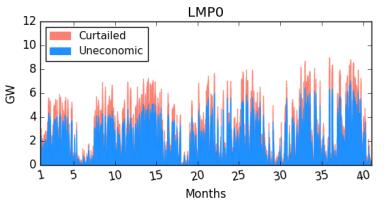 Figure 1. Stranded wind power in the MISO grid, curtailed (red) and uneconomic (blue), March 1, 2013-June 30, 2016. (LMP0).
Figure 1. Stranded wind power in the MISO grid, curtailed (red) and uneconomic (blue), March 1, 2013-June 30, 2016. (LMP0).To empirically characterize stranded power, we analyze the real-time market cleared offers (RTOs) for the Midcontinent Independent System Operator (MISO) [37] power market as described in Table 2. More detail on the MISO power grid is given in Section 2.3. The RTO's include locational marginal price (LMP), offered power, cleared power, offered price, and a wealth of other data for 5-minute intervals. MISO includes significant generation from coal, nuclear, and natural gas, but we focus on the largest source of renewable power, wind turbines that account for
†Some smaller sites do not bid Economic Max, allowing MISO to forecast for them. This service was offered by MISO to ease integration for small generators, and produces RTO's with no Economic Max values. As a result, these sites account for only 9.6% of the wind power. We exclude these sites, reducing the sites consider from 206 to 137 and thus our measurements underestimate stranded power.
| Parameter | Value |
| Period | 3/1/2013—7/1/2016 |
| Generation Sites | 1,329 Total, 206 Wind |
| 5-minute Intervals | 207,621,612 Total, 59,459,126 Wind |
| Total TWh | 1951.58 Total, 136.63 Wind |
| Total $'s Power | $56.8 B Total, $2.4 B Wind |
| Real-Time Offer (value) | Description |
| Time | Start Time of the 5-minute interval |
| Economic Max | Power offered by generator (next interval) |
| Delivered MW | Delivered power for the interval |
| LMP | Locational Marginal Price for interval |
We document the wind generation nameplate capacity for the MISO grid (see Figure 2) that has grown steadily, from a base of 13 GW in 2013 to nearly 15 GW in 2016. Wind production has grown even faster, approaching 40 terawatt-hours (TWH) in 2015, and in a seasonally adjusted projection expected to exceed 40 TWH in 2016 (see Figure 3). Analysis of key statistics for wind generation sites shows a decided shift to larger wind sites (see Table 3), the largest site is nearly 500 MW.
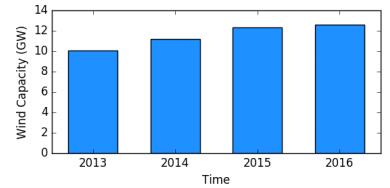 Figure 2. MISO grid wind nameplate capacity.
Figure 2. MISO grid wind nameplate capacity.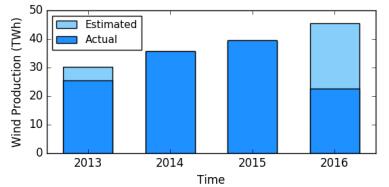 Figure 3. Wind generation in MISO. Estimates for 2013 due to market startup JanuaryFebruary, and for 2nd half 2016. The estimates are scaled to 12 months based on seasonal variation.
Figure 3. Wind generation in MISO. Estimates for 2013 due to market startup JanuaryFebruary, and for 2nd half 2016. The estimates are scaled to 12 months based on seasonal variation.| Year | Total | Sites | Mean | StdDev | Max |
| 2013 | 10,048 | 115 | 87 | 62 | 289 |
| 2014 | 11,194 | 128 | 87 | 64 | 356 |
| 2015 | 12,312 | 135 | 91 | 69 | 497 |
| 2016 | 12,590 | 137 | 92 | 69 | 497 |
We define two families of stranded power models. First, instantaneous stranded power is defined as the power delivered in the 5-minute intervals where the locational marginal price is negative or zero; we call these models LMP(C), and consider LMP0. Second, we also define the net price model, NP(C), where the average power price over a set of contiguous 5-minute intervals is C dollars/MWh, considering NP0 and NP5. We define each of these formally below:
Instantaneous Stranded Power: LMP(C)
| $ LMP<C ~~~ where ~~ C = price~ threshold $ | (3.1) |
Net Price Stranded Power: NP(C)
| $ NetPrice<C ~~~ where ~~ C = price~ threshold $ | (3.2) |
| $ NetPrice = \frac{\sum_{period}LMP\cdot Power}{\sum_{period}Power}, Power~\textrm{in MWh} $ | (3.3) |
We apply the LMP0, NP0, and NP5 stranded power models to the MISO market records. LMP0 represents the corresponds to the simplest definition of uneconomic power. NP0 represents a more flexible definition of uneconomic, and NP5 represents power that may in fact be uneconomic for wind generators (absent subsidies). To characterize stranded power we use the following metrics: instantaneous quantity (MW or GW), aggregate quantity (GWh or TWh), and duty factor (fraction of time available). An important characteristic for usability is the period of contiguous time that stranded power is available, an interval. We study distributions of stranded power interval durations.
We first explore the temporal behavior of stranded power, looking across the entire grid. This broad view provides a global characterization of the aggregate quantities of a rapidly fluctuating, distributed phenomenon. This global characterization shows both the limitations of today's grid in absorbing wind generation, and the upper bound on what stranded power could be captured and exploited. First, Figure 1, already discussed, shows instantaneous stranded power, LMP0, peaking at 8 GW, has steep fluctuations, and shows uneconomic power as much larger than curtailment. Using a more flexible definition, NP0, not only increases the quantity of stranded power significantly, but also smooths troughs significantly (see Figure 4). A critical challenge for renewables is economic viability, so NP5 allows a low average price for power ($5/MWH, about one-fifth the market price). NP5 increases the quantity of stranded power significantly and further smooths the troughs (see Figure 5).
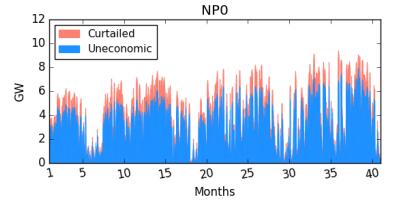 Figure 4. Curtailed (red) and uneconomic (blue) wind generated power in the MISO grid, March 1, 2013-June 30, 2016. (NP0).
Figure 4. Curtailed (red) and uneconomic (blue) wind generated power in the MISO grid, March 1, 2013-June 30, 2016. (NP0).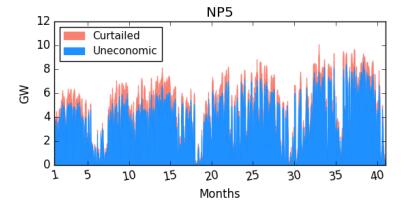 Figure 5. Curtailed (red) and uneconomic (blue) wind generated power in the MISO grid, March 1, 2013-June 30, 2016. (NP5).
Figure 5. Curtailed (red) and uneconomic (blue) wind generated power in the MISO grid, March 1, 2013-June 30, 2016. (NP5).Looking at the three stranded power models together (Figure 6), we can see that shifting from an instantaneous pricing model to an average price model, NP0, increases the quantity of stranded power by nearly 30%. In NP5, adding the $5/MWH increases the available stranded power by another 15-20%. Comparing the stranded power totals to the total wind production in Figure 3, shows that a large fraction, approximately 30%, of MISO's wind power is stranded.
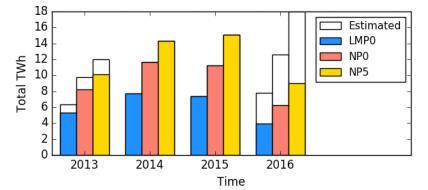 Figure 6. Total stranded power for the MISO Grid (2013-2016), various models.
Figure 6. Total stranded power for the MISO Grid (2013-2016), various models.The key challenge for stranded power utilization is its intermittence. Reliability in power grids is a critical feature, though outages are inevitable. To evaluate the usability of stranded power we consider the time intervals that it is available and their duration. In Figure 7 we show the fraction of intervals of each duration, by count; surprisingly there are many stranded power intervals longer than 10, 50, even 100 hours. However, weighting by count overweights short intervals that are numerous, but contribute little to temporal availability. To understand how intervals of various durations contribute to duty factor, we plot this directly in Figure 8. The resulting plot clearly shows that the vast majority of duty factor comes from long intervals, more than 50 or even 100 hours long. Further, the duty factor for stranded power, grid-wide, is 99.8%; there is stranded power present in the grid nearly all of the time. Interval statistics for all three models are presented in Table 4, and show that the average interval duration in longer than 100 hours, and the longest interval is over 800 hours (more than a month).
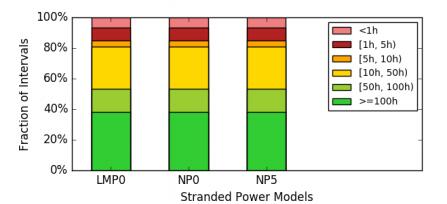 Figure 7. Interval statistics for the entire grid (average by count of intervals).
Figure 7. Interval statistics for the entire grid (average by count of intervals).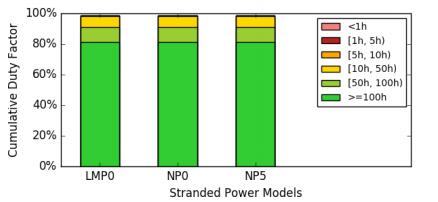 Figure 8. Interval statistics for the entire grid (contribution to duty factor).
Figure 8. Interval statistics for the entire grid (contribution to duty factor).| Year | #Intervals | Total | Mean | StdDev | Max |
| LMP0 | 263 | 28,903 | 109.9 | 131.3 | 816.5 |
| NP0 | 263 | 28,903 | 109.9 | 131.3 | 816.5 |
| NP5 | 263 | 28,903 | 109.9 | 131.3 | 816.5 |
Next, we consider the duty factor that can be achieved at various power levels, to characterize how much power is available. As the power level increases, more intervals will be characterized as "insufficient", and switch from stranded power available to an outage. As shown in Figure 9, the duty factors begin at 55%, 48%, and 33% for NP5, NP0, and LMP0 respectively, and decrease as the power requirement is increased. At 1 GW, the duty factors range from 40% down to 20%.
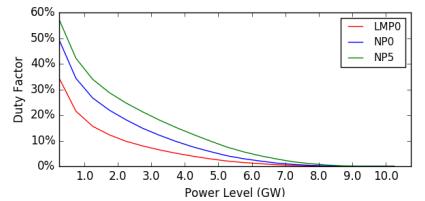 Figure 9. Duty factor vs. power level for whole grid.
Figure 9. Duty factor vs. power level for whole grid.Societal activity often has a diurnal, weekly, or even seasonal structure; we explore how stranded power varies with these temporal periods. Beginning with seasons, Figure 10 shows the aggregate stranded power by season, showing that wind stranded power correlates with high levels of productivity in fall and spring, but is anticorrelated with load which peaks in the summer for MISO.
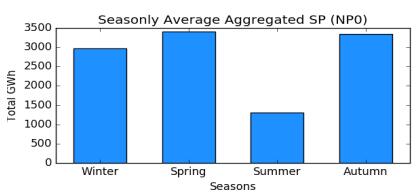 Figure 10. Total stranded power, seasonal average for the entire grid. March 21, 2013-March 20, 2016 (three years).
Figure 10. Total stranded power, seasonal average for the entire grid. March 21, 2013-March 20, 2016 (three years).Next we consider time of day, plotting the stranded power against time of day (see Figure 11), and using the more than one thousand days in the period of study. The diurnal trends are clear, with 100's of MW more stranded power available on average during late-night, early morning hours (off-peak). While stranded averages around 1.5 GW, the peaks exceed 8 GW (see Figure 4).
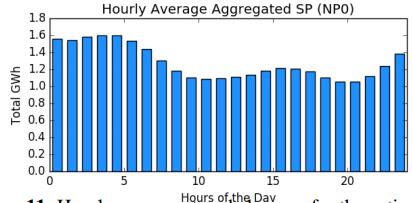 Figure 11. Hourly average stranded power for the entire grid.
Figure 11. Hourly average stranded power for the entire grid.The seasonal variation of stranded power is so striking that we also combined it with day-of-week (see Figure 12) and hourly binning (see Figure 13) to determine if the different temporal structures are independent. The figures suggest that they are largely independent, showing striking seasonal variation in magnitude of average stranded power in both graphs. The weekly substructure seems less uniform across seasons, but the hourly substructure is quite uniform.
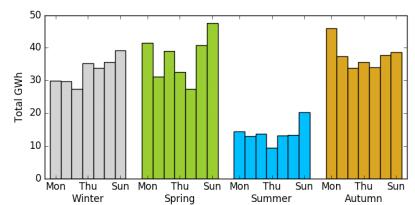 Figure 12. Combined seasonal and day of week averages for entire grid. March 21, 2013-March 20, 2016 (three cycles of seasons).
Figure 12. Combined seasonal and day of week averages for entire grid. March 21, 2013-March 20, 2016 (three cycles of seasons).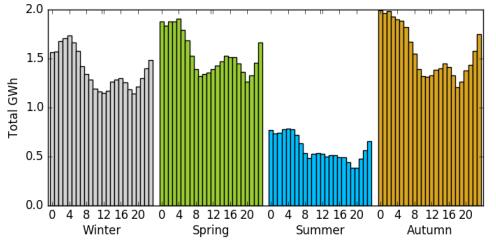 Figure 13. Combined seasonal and hourly averages for entire grid. March 21, 2013-March 20, 2016 (three cycles of seasons).
Figure 13. Combined seasonal and hourly averages for entire grid. March 21, 2013-March 20, 2016 (three cycles of seasons).Next, we consider the properties of stranded power at single sites. A local view of stranded power not only characterizes the worst case for a wind generator -how much power is being stranded -and the potential for exploitation -via colocation. Here we consider the most extreme stranded power sites by three criteria: 1) the top duty factor, 2) the top 5 duty factor, and 3) the top 5 quantity. First, looking at the top duty factor site, Figure 14 shows that this site has 100 MW of stranded power in many intervals. Looking across the top 5 duty factor sites, stranded power can be a high as 400 MW, with large quantities (see Figure 15).
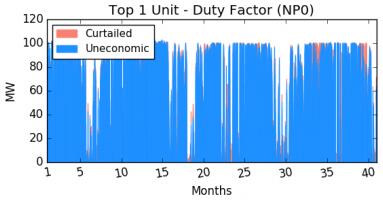 Figure 14. Stranded power quantity vs. time for site with highest duty factor.
Figure 14. Stranded power quantity vs. time for site with highest duty factor.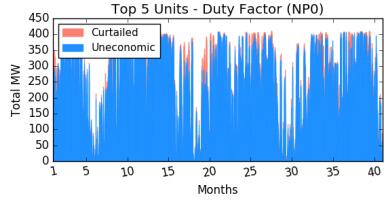 Figure 15. Stranded power quantity vs. time for 5 sites with highest duty factor.
Figure 15. Stranded power quantity vs. time for 5 sites with highest duty factor.Analyzing the interval statistics, Figure 16 shows that short intervals dominate by count in both the top duty site, as well as the top 5 duty factor sites. In both cases, it is important to note that the preponderance of short intervals does not mean that there are no long intervals. In fact, most of the duty comes from intervals longer than 5 hours, and large fractions from intervals longer than 10 hours. The long intervals produce most of the duty factor (see Figure 17), accounting for nearly 50% of the 70% overall duty factor. These results show that the top 5 duty factor sites are generally similar to the top site with similar contribution to duty factor from long intervals.
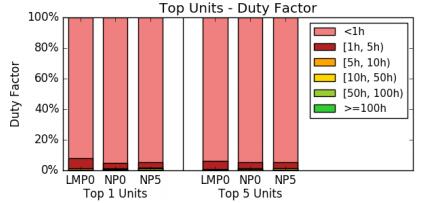 Figure 16. Interval statistics by count for sites with highest duty factor.
Figure 16. Interval statistics by count for sites with highest duty factor.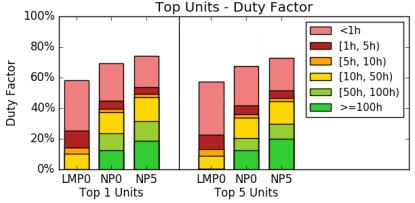 Figure 17. Interval statistics by contribution to duty factor for sites with highest duty factor.
Figure 17. Interval statistics by contribution to duty factor for sites with highest duty factor.We consider the duty factor, as a function of power level, characterizing the duty that could be supported with stranded power at a given power level (see Figure 18). Loads of 4MW, 8MW, and 16MW can be supported at duty factors of 40%, 38%, and 36% respectively with intervals on average much larger than a few hours.
 Figure 18. Duty factor vs. power for sites with highest duty factor (np0).
Figure 18. Duty factor vs. power for sites with highest duty factor (np0).Considering sites with the most stranded power, we find over 250 MW power (see Figure 19 and 20) and high variation. On these sites uneconomic power is far more than curtailed (Table 5). Even considering the top 5 sites, power levels as high as 100's of MW per site can be available.
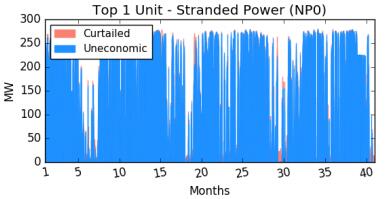 Figure 19. Quantity vs. time for site with most stranded power.
Figure 19. Quantity vs. time for site with most stranded power.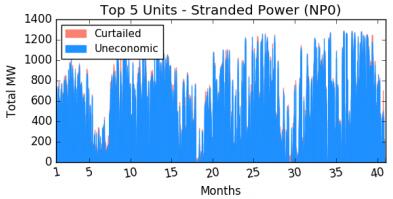 Figure 20. Quantity vs. time for 5 sites with most stranded power.
Figure 20. Quantity vs. time for 5 sites with most stranded power.| Type | #Hours | Mean | StdDev | Max | |
| Top1 | Uneconomic | 9,296 | 147.2 | 92.4 | 280.4 |
| Top1 | Curtailment | 26,790 | 5.6 | 8.5 | 215.9 |
| Top5 | Uneconomic | 15,569 | 330.2 | 300.0 | 1,285.7 |
| Top5 | Curtailment | 29,214 | 20.6 | 20.4 | 486.0 |
Considering interval statistics for these sites with the most stranded power, we find a similar story. Figures 21 and 22 show that short intervals dominate by count but long intervals produce most of the duty factor, accounting for nearly 30% of the 60% overall duty factor.
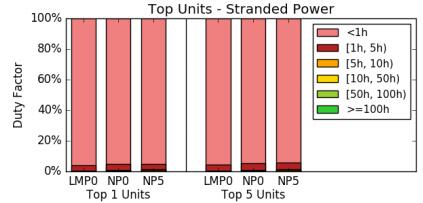 Figure 21. Interval statistics by count for sites with most stranded power.
Figure 21. Interval statistics by count for sites with most stranded power.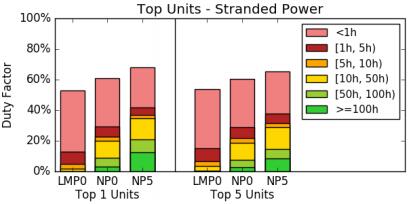 Figure 22. Interval statistics by contribution to duty factor for sites with most stranded power.
Figure 22. Interval statistics by contribution to duty factor for sites with most stranded power.We consider duty factor as a function of power level, and here there is more power available (see Figure 23). Loads of 4MW, 8MW, 16MW, and 32 MW can be supported at duty factors of 45%, 40%, 35%, and 30% respectively with intervals on average much larger than a few hours.
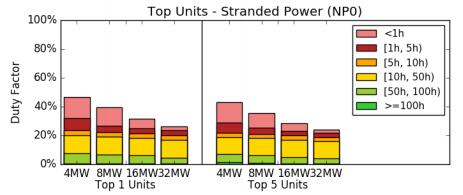 Figure 23. Duty factor vs. power for top sites with most stranded power (np0).
Figure 23. Duty factor vs. power for top sites with most stranded power (np0).We consider enhancing the utility of stranded power by adding energy storage [38,39,40] to explore the incremental benefits and realizable improvements. We first consider global storage, then local storage, and finally intelligently placed storage. The major challenge with storage in the power grid is the vast scale of the power involved in the swings of variable generation. We consider several scenarios of grid-augmentation with storage that first bound the potential benefit and then seek to characterize realistic benefits.
The key functional parameters for energy storage include 1) Rate of charge (MW) and 2) Capacity (MWH). We consider a variety of capacities, charging rates, and connectivities. And, because the desired use of power affects the best management of the energy storage, our experiments involve a desired load. For Load, we use a constant level of power (e.g., 4 MW, 8 MW, 32 MW, etc.), varying its magnitude to assess stranded power utility. Precisely, storage is managed as in Algorithm 1.
We first consider an idealized scenario, global energy storage that can be directly connected to all parts of the power grid. This scenario ignores all location and transmission constraints, so it provides an upper bound on the benefits of energy storage. We add energy storage with 1 GW rate and 8 hours capacity, comparable to the aggregate scale of California's "grid storage systems" [40], recently contracted (but configuration not disclosed). The results for MISO stranded power are shown in Figure 24 that displays the additional power availability due to energy storage as brown (compare to Figure 4). Because the impact is small, we zoom in on the month with the most stranded power to illustrate the detailed structure of how storage fills in when stranded power is not available (Figure 25).
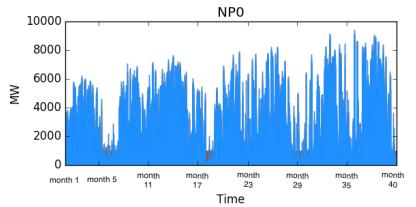 Figure 24. Total stranded power vs. time : with 8 hr 1 GW ideal global storage.
Figure 24. Total stranded power vs. time : with 8 hr 1 GW ideal global storage.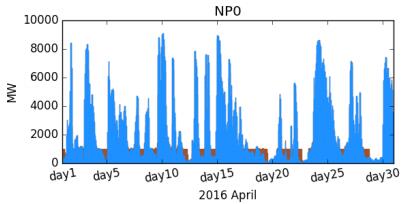 Figure 25. Total power vs time (April 2016-most stranded power month): With 8 hr 1 GW storage.
Figure 25. Total power vs time (April 2016-most stranded power month): With 8 hr 1 GW storage.Adding storage does increase the duty factor of the MISO grid, but despite ignoring transmission constraints (idealized global storage), the incremental benefits fall off rapidly. As shown in Figure 26, adding 1 and 2 hours of storage can improve the duty factor. At 0.25GW load, 1 hour of storage increases duty factor to 82% (a 15% increase). But, benefits decrease rapidly, with minimal benefits beyond 8 hours. At higher power levels, the achievable duty factor falls off significantly with 62% and 46% achievable for 1 GW and 2 GW respectively.‡
‡Note that 2 GWh at 2015 battery prices [39] is over $1.2B, or even 2nd generation variants ($600M) or cheaper alternatives, comparable to the cost of approximately 200 MW installed wind turbines.
 Figure 26. Duty factor of ideal global storage, NP0.
Figure 26. Duty factor of ideal global storage, NP0.Next, we consider a more realistic scenario that distributes storage uniformly to all wind generation sites. This scenario assumes that transmission is limited (or costly), and the storage is only used to store the stranded power generated locally, and only provides power locally.
We experiment with different amounts of energy storage, 5, 10, 25, 50, and 100 hours for the load, but presume energy storage that can charge at the full rate of local generation (realistic for cell battery approaches, but perhaps not for lower cost options such as pumped hydro or flow batteries). We compare to duty factor without storage as shown in Figure 27. The designated load affects the discharge time, so we vary the load from 4 MW, 8 MW, 16 MW, to 32 MW. The corresponding storage capacity being added to the grid grows as the product of duration and power level at each of the over 200 wind farm sites as shown in Table 6.
| Algorithm 1 Energy storage management |
| if strandedPower > load then |
| ChargeAt max[rate, strandedPower − load] |
| Load is on |
| else |
| if storage + strandedPower ≥ load then |
| ChargeAt (strandedPower − load) |
| Load is on |
| else |
| ChargeAt strandedPower |
| Load is off |
| end if |
| end if |
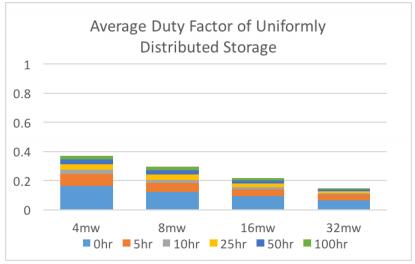 Figure 27. Average of site duty factors for uniformly distributed energy storage.
Figure 27. Average of site duty factors for uniformly distributed energy storage.| 5 | 10 | 25 | 50 | 100 | |
| 4 MW | 20 | 40 | 100 | 200 | 400 |
| 8 MW | 40 | 80 | 200 | 400 | 800 |
| 16 MW | 80 | 160 | 400 | 800 | 1,600 |
| 32 MW | 160 | 320 | 800 | 1,600 | 3,200 |
Our results show that 5 hours significantly increases the duty factor at all power levels, but the benefits diminish quickly. And that duty factors of 20-45% on average are achievable. Note that these are the average duty factors across the entire set of wind generation sites, so we will see much higher duty factors for individual sites. Note that these quantities of storage go far beyond that economically viable. For example, Tesla's Powerwall 2 is approximate $300M per GWh, so even much cheaper storage would cost billions at this scale.
Next we consider how much storage would be required to turn intermittent sites into reliable power sites (100% duty). That is, can we easily turn stranded power into reliable continuous power? As show in Figure 28, it takes a large amount of storage to make any sites reliable. For 4 MW, a few sites can make it with 25-100 hours, but for any higher power levels, increases beyond 250 hours (10 days!) are required. Referring to Table 6, 50 hours of storage for 4-32 MW, ranges from 200 MWh to 1,600 MWh per site, or approximately $50M to $400M, comparable to the wind turbine costs.
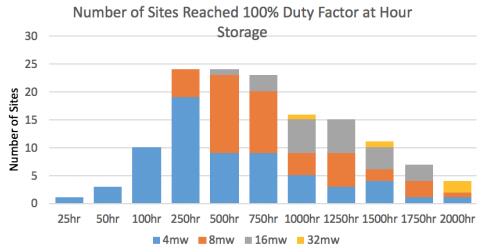 Figure 28. # Sites reaching 100% duty factor at given storage capacity.
Figure 28. # Sites reaching 100% duty factor at given storage capacity.Uniform distribution of storage places it inefficiently, adding it where little stranded power occurs, and thus deriving less benefit. We consider intelligent placement, picking to two types of promising sites-those where the maximum quantity of stranded power is being generated, and those where the maximum duty factor of stranded power occurs.
Figures 29 and 30 show that storage placed at the top duty factor and top stranded power sites gives much greater benefits. From a much higher base, adding 5 hours of storage can raise duty factors to as much as 75-85%. And even at higher power levels of 32 MW, storage is highly productive, and can lift duty factors to over 75%. These benefits and absolute duty factors achieved are more than 2x better for uniformly-distributed storage (Figure 27). Clearly, investment in expensive energy storage will be yield much greater benefits at these few top sites, compared to uniformly distributed storage.
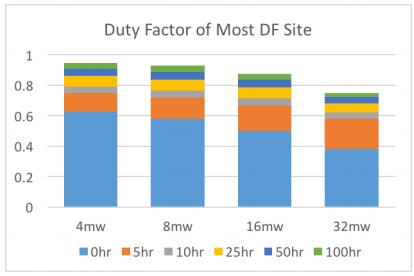 Figure 29. Storage benefits duty factor of highest duty factor site(single site), NP0.
Figure 29. Storage benefits duty factor of highest duty factor site(single site), NP0.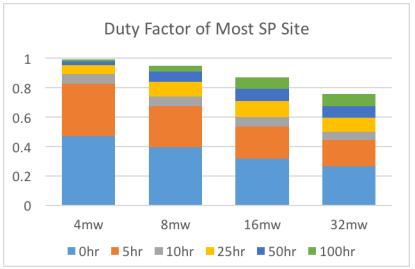 Figure 30. Storage benefits duty factor of most stranded power site(single site), NP0.
Figure 30. Storage benefits duty factor of most stranded power site(single site), NP0.To see how robust these differences are, we consider the top 5 in each of the duty factor and stranded power (Figure 31) categories. Again these results show that much greater storage benefits can be achieved at the top duty factor and top stranded power sites. With 5 hours, duty factors reach 75%, and higher power levels up to 32 MW, storage's benefits are robust across a collection of sites.
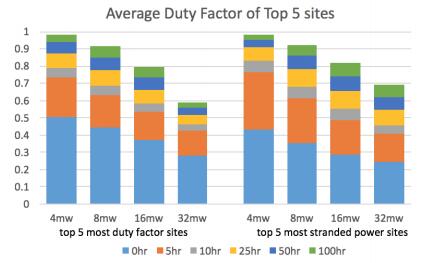 Figure 31. Average duty factor with energy storage, top 5 Sites, NP0.
Figure 31. Average duty factor with energy storage, top 5 Sites, NP0.We evaluate the effectiveness of storage placement by the total power it serves (captures). In Figure 32, we compare global storage and uniformly distributed storage. Interestingly, the comparison shows that global storage is only slightly better than uniformly distributed storage. The Comparison of two intelligent distribution schemes (see Figure 33) shows clearly that energy storage deployed at the top 5 sites can be as much as 3.7 times more productive.
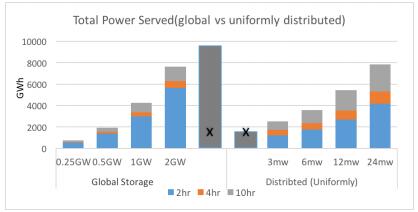 Figure 32. Total power served by energy storage: Global vs. uniformly distributed.
Figure 32. Total power served by energy storage: Global vs. uniformly distributed.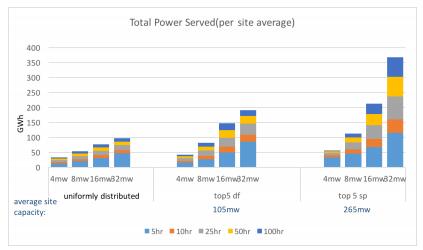 Figure 33. Total power served(Site Average) of per site placed storage.
Figure 33. Total power served(Site Average) of per site placed storage.To get directly at cost-benefit, we plot the duty factor benefit per unit storage, for a variety of power levels and storage capacities (see Figure 34). These results show a rapid downward trend as storage capacity increases, going from 5 to 50 hours, the benefit per unit decreases by 4-10 fold. This suggests that even if small quantities of storage become economically viable, large quantities may not.
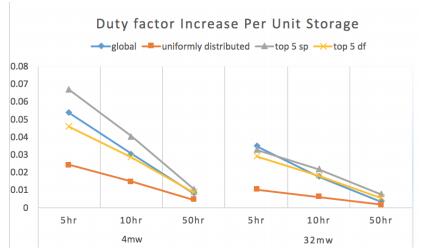 Figure 34. Duty factor increase per unit/hour storage.
Figure 34. Duty factor increase per unit/hour storage.Stranded power has been documented as a large, growing untapped resource. Published reports document that the Midcontinent Independent System Operator (MISO) power grid curtailed 2.2 terawatt-hours (TWh) of power (see Figure 1) and bought 5.5 TWh at negative price for a total of 7.7 TWh of stranded power from wind resources [11,16,29]. And in China, curtailed wind power has grown to 34 TWh in 2015 [12], suggesting stranded power of 60-100 TWh. Around the world, as renewable generation fraction increases due to rising RPS standards, stranded power is projected to increase significantly [11,18,41]. All of these efforts report aggregated curtailment over entire dispatch regions, and often at a coarse temporal granularity (months or years). The reason is that these studies are concerned with effectiveness of incorporating renewable-generators power with the goal of reducing carbon emissions, and grid generator economic viability. To our knowledge, this study is the first that looks at fine-grained curtailed power availability, and adds to that a fine-grained temporal analysis of uneconomic power -together stranded power.
Numerous studies explore challenges in renewable integration, assessing concerns of grid stability, ability to achieve "merit order", and also the dynamics of markets [11,17,18]. These studies generally point out the daunting challenges to grid operations as RPS standards continue to rise, and suggest that the stranded power we have studied is a significant and persistent phenomena. In fact several recent studies suggest that stranded power likely to grow rapidly in both wind-heavy [41] and solar-heavy [8,17,18] renewable power grids. Such results suggest that the study of stranded power is of increasing importance.
In addition to broad demand-response studies, and specific load shifting and demand-response [42,43,44], several studies explore data-center demand-response (DCDR) [45]; in other work, we have proposed a new model where data centers can be "dispatchable loads" based on new computer science approaches to create flexible computing loads [28,46,47,48]. These data centers have the dynamic range for load (10's of MW) that can exploit stranded power at the scales we have characterized.
Progress in energy storage is promising [49], but the low price of power makes its large-scale deployment for time-shifting challenging [8] and some studies suggest on energy return-on-investment (EROI) criteria, it may never make sense to store large quantities of wind power [50]. Adding energy storage to distributed (residential) solar has recently become popular [39], but grid-scale storage for time-shifting, rather than small quantities for peak shaving and regulation, faces significant economic challenges. Recent years have seen the deployment of experimental scale battery storage, primarily for regulation [38,40] and the ancillary services market. It is worth noting that the largest of these, in CAISO, will deploy 1.3 GW of storage by 2024, a small fraction of the quantity of storage considered in Section 5, and our results (recall Figure 28) shows diminishing returns for each increment of storage.
The MISO dispatch region has unique characteristics: significant nuclear, coal, and wind generation, and a mix of residential and industrial customers. It has growing natural gas generation, due to inexpensive US natural gas. Such flexible generation has the potential to offset variable generation when its not available, but such intermittent use of expensive plants presents significant economic challenges. Likewise, the addition of more transmission capacity could reduce stranded power, as it did with ERCOT in Texas, but the economics of such transmission lines, and their public acceptance is challenging. Aside these economic challenges, perhaps the most promising approach to slow stranded power growth is advanced load management, shifting load to when variable generation is plentiful, and away when it is scarce. Technically promising, infrastructure for it is immature at present.
We have presented a detailed temporal and spatial study of stranded power (curtailed and uneconomic power) arising in a modern power grid. Our results show the large magnitude (terawatt-hours) and nature of this phenomenon (intermittent, with long intervals) in a power grid with wind-based renewable generation. The magnitude of available stranded power in long intervals (multiple days) suggests that exploitation may be possible. The MISO grid we studied has a low RPS, only 10% wind, suggesting that higher RPS grids may have even more attractive stranded power resources.
Study of enhancing usability of stranded power with storage suggests that while small quantities of storage can significantly increase duty factors, and by choosing sites carefully, the effectiveness can be even greater. However, approaching 100% (reliable grid power) would require extremely large quantities of storage. Promising directions for future research include study of a high-RPS solar grid such as CAISO and higher-RPS grids.
This work was supported by in part the Office of Advanced Scientific Computing Research, Office of Science, U.S. Department of Energy, under Award DE-SC0008603 and Contract DE-AC02-06CH11357, as well as the National Science Foundation under Awards CNS-1405959.
The authors declare no conflict of interest in this paper.
| [1] | Intergovernmental Panel on Climate Change (2014) Climate change 2014: Synthesis report. Available from: http://www.ipcc.ch. |
| [2] | Gore A (2006) An inconvenient truth. Documentary Film. |
| [3] | United Nations Framework Convention on Climate Change (1997) Kyoto protocol. Available from: http://unfccc.int/kyoto_protocol/items/2830.php. |
| [4] | United Nations Framework Convention on Climate Change (2015) Paris climate change conference. Available from: http://unfccc.int/meetings/paris_nov_2015/meeting/8926.php. |
| [5] | California Public Utilities Commission (CPUC) Available from: http://www.cpuc.ca.gov/ PUC/energy/Renewables. |
| [6] | Megerian C, et al. (2015) Gov. Brown signs climate change bill to spur renewable energy, e ciency standards. Los Angeles Times Newspaper. |
| [7] | US EPA (2015) Plan requirements for greenhouse gas emissions from electric utility generating units constructed on or before january 8, 2014; model trading rules. Federal Register. |
| [8] | Denholm P, Margolis R (2016) Energy storage requirements for achieving 50% solar photovoltaic energy penetration in california. Tech. rep., US Department of Energy, National Renewable Energy Laboratory. |
| [9] | Renewable Energy13.4% of US Electricity Generation in 2014. Available from: http: //cleantechnica.com/2015/03/10/renewable-energy-13-4-of-us-electricity- generation-in-2014-exclusive/. |
| [10] | Lew D, et al. (2013) Wind and solar curtailment. In: International Workshop on Large-Scale Integration of Wind Power Into Power Systems. |
| [11] | Bird L, et al. (2013) Integrating variable renewable energy: Challenges and solutions. National Renewable Energy Laboratory . |
| [12] | GWEC (2016) Global wind report: Annual market update. Tech. rep., GlobalWind Energy Council. Documents curtailment around the world. |
| [13] | Steel J (2015) The what, when and how of texas electricity prices going negative. Available from: https://cleantechnica.com/2015/10/01/texas-electricity-prices- going-negative/. |
| [14] | Coren M J (2016) Germany had so much renewable energy on sunday that it had to pay people to use electricity. Available from: http://qz.com/680661/germany-had-so-much-renewable- energy-on-sunday-that-it-had-to-pay-people-to-use-electricity/. |
| [15] | Martin R (2016) Germany runs up against the limits of renewables. Technology Review . |
| [16] | Bird L, Cochran J, Wang X (2014) Wind and Solar Energy Curtailment: Experience and Practices in the United States. Tech. rep., NREL. |
| [17] | Paul Denholm K C, O'Connell M (2016) On the path to sunshot: Emerging issues and challenges in integrating high levels of solar into the electrical generation and transmission system. Tech. rep., US Department of Energy, National Renewable Energy Laboratory. |
| [18] | E3 (2014) Investigating a higher renewables portfolio standard in california: Executive summary. Tech. rep., Report from Energy and Economics, Inc. |
| [19] | Martin R (2016) Texas and california have too much renewable energy. Technology Review . |
| [20] | Krauss C, Cardwell D (2015) A texas utility o ers a nighttime special: Free electricity. Available from: http://nyti.ms/1kDA8Iu. |
| [21] | MISO. Revenue su ciency guarantees. |
| [22] | Wiser R H, Mills A D, Seel J, et al. (2017) Impacts of variable renewable energy on bulk power system assets, pricing, and costs. Tech. Rep. LBNL-2001082. A link to a webinar recorded on December 13, 2017 can be found at https://youtu.be/EMrFAklQnPI. |
| [23] | Kies A, Schyska B U, von Bremen L (2016) Curtailment in highly renewable power system and its e ect on capacity factors. Energies 9. |
| [24] | Power outages a ect thousands in San Diego. http://www.10news.com/news/power- outages-affecting-thousands-in-san-diego-092015. |
| [25] | California ISO (CAISO), Locational Marginal Pricing (LMP): Basics of Nodal Price Calculation. Tech. rep., CAISO Market Operations. |
| [26] | Megerian C, Panzar J (2015) Gov. Brown signs climate change bill to spur renewable energy, e ciency standards. Los Angeles Times Newspaper. |
| [27] | Wind Vision. http://energy.gov/eere/wind/wind-vision. |
| [28] | Chien A A, et al. (2015) The zero-carbon cloud: High-value, dispatchable demand for renewable power generators. The Electricity Journal 110–118. |
| [29] | Yang F, Chien A A (2016) ZCCloud: Exploring Wasted Green Power for High-Performance Computing. In: IPDPS'16. |
| [30] | na. Water splitting. Available from: https://en.wikipedia.org/wiki/Water_splitting. |
| [31] | na. Haber process: Nitrogen fixing. Available from: https://en.wikipedia.org/wiki/ Haber_process. |
| [32] | Antminer. Antminer s9, bitcoin mining accelerator. Available from: http://www. antminerdistribution.com/antminer-s9/. |
| [33] | The us digital manufacturing design innovation institute. Available from: http://dmdii. uilabs.org/. |
| [34] | Fikes B J (2015) State's biggest desal plant to open: What it means. Available from: http://www.sandiegouniontribune.com/news/environment/sdut-poseidon- water-desalination-carlsbad-opening-2015dec13-htmlstory.html. |
| [35] | Kintisch E (2014) Can sucking co2 out of the atmosphere really work? Technology Review https://www.technologyreview.com/s/531346/can-sucking-co2-out-of-the- atmosphere-really-work/. |
| [36] | Fu Y, Li Z (2006) Di erent models and properties on lmp calculations. In: 2006 IEEE Power Engineering Society General Meeting, 11 pp.–. |
| [37] | MISO. https://www.misoenergy.org/. |
| [38] | CAISO (2014) Iso storage pilot projects. https://www.caiso.com/Documents/ FastFacts_ISOStoragePilotProjects-AdvancingSmarterGrid.pdf. |
| [39] | Tesla (2016) TeslaPowerwall. https://en.wikipedia.org/wiki/Tesla_Powerwall. 40.CPUC (2013) Energy storage procurement framework and design program. http://docs.cpuc. ca.gov/PublishedDocs/Published/G000/M078/K912/78912194.PDF. |
| [40] | 41.Kim K, Yang F, Zavala V, et al. (2016) Data centers as dispatchable loads to harness stranded power. IEEE Transactions on Sustainable Energy DOI 10.1109/TSTE.2016.2593607. |
| [41] |
42.Han S, et al. (2010) Development of an optimal vehicle-to-grid aggregator for frequency regulation. Smart Grid, IEEE Transactions on 1: 65–72. doi: 10.1109/TSG.2010.2045163

|
| [42] |
43.Zhao P, et al. (2013) Evaluation of commercial building HVAC systems as frequency regulation providers. Energy and Buildings 67: 225–235. doi: 10.1016/j.enbuild.2013.08.031

|
| [43] | 44.Todd D, et al. (2008) Providing reliability services through demand response: A preliminary evaluation of the demand response capabilities of Alcoa Inc. ORNL/TM 233. |
| [44] | 45.Zhenhua Liu I L, Mohsenian-Rad H, Wierman A (2014) Opportunities and challenges for data center demand response. In: Proceedings of IGCC. IEEE. |
| [45] | 46.Yang F, et al. (2016) ZCCloud: Exploring wasted green power for high-performance computing. In: IPDPS 2016. IEEE. |
| [46] | 47.Chien A A, et al. (2015) Zero-Carbon Cloud: High-value, Dispatchable Demand for Renewable Power Generators. Electricity Journal . |
| [47] | 48.Yang F, Chien A A (2017) Extreme scaling of supercomputing with stranded power: Costs and capabilities. IEEE Transactions on Parallel and Distributed Systems . |
| [48] | 49.International Renewable Energy Agency (2015) Renewables and electricity storage: A technology roadmap for remap 2030. Tech. rep., IRENA. https://www.irena.org/DocumentDownloads/ Publications/IRENA_REmap_Electricity_Storage_2015.pdf. |
| [49] | 50.Barnhart C, Dale M, Brandt A, et al. (2013) The energetic implications of curtailing versus storing solar- and wind-generated electricity. Energy and Environmental Science 6. DOI:10.1039/c3ee41973h. |
| 1. | Tom Wirtanen, Tobias Prenzel, Jean-Philippe Tessonnier, Siegfried R. Waldvogel, Cathodic Corrosion of Metal Electrodes—How to Prevent It in Electroorganic Synthesis, 2021, 121, 0009-2665, 10241, 10.1021/acs.chemrev.1c00148 | |
| 2. | Chaojie Zhang, Andrew A. Chien, 2021, Chapter 10, 978-3-030-88223-5, 190, 10.1007/978-3-030-88224-2_10 | |
| 3. | Bilge Acun, Benjamin Lee, Fiodar Kazhamiaka, Kiwan Maeng, Udit Gupta, Manoj Chakkaravarthy, David Brooks, Carole-Jean Wu, 2023, Carbon Explorer: A Holistic Framework for Designing Carbon Aware Datacenters, 9781450399166, 118, 10.1145/3575693.3575754 |
| Term | Definition |
| RPS | Renewable Portfolio Standard |
| LMP | Locational Marginal Pricing |
| LMPx | A model that counts power dispatched at less that x $/MWh as uneconomic |
| NPx | A model that counts power dispatched at average price |
| MWh, GWh, TWh | Megawatt-Hour, Gigawatt-Hour, Terawatt-Hour |
| RTO | Real-time Offers (bids in the real-time market) |
| Parameter | Value |
| Period | 3/1/2013—7/1/2016 |
| Generation Sites | 1,329 Total, 206 Wind |
| 5-minute Intervals | 207,621,612 Total, 59,459,126 Wind |
| Total TWh | 1951.58 Total, 136.63 Wind |
| Total $'s Power | $56.8 B Total, $2.4 B Wind |
| Real-Time Offer (value) | Description |
| Time | Start Time of the 5-minute interval |
| Economic Max | Power offered by generator (next interval) |
| Delivered MW | Delivered power for the interval |
| LMP | Locational Marginal Price for interval |
| Year | Total | Sites | Mean | StdDev | Max |
| 2013 | 10,048 | 115 | 87 | 62 | 289 |
| 2014 | 11,194 | 128 | 87 | 64 | 356 |
| 2015 | 12,312 | 135 | 91 | 69 | 497 |
| 2016 | 12,590 | 137 | 92 | 69 | 497 |
| Year | #Intervals | Total | Mean | StdDev | Max |
| LMP0 | 263 | 28,903 | 109.9 | 131.3 | 816.5 |
| NP0 | 263 | 28,903 | 109.9 | 131.3 | 816.5 |
| NP5 | 263 | 28,903 | 109.9 | 131.3 | 816.5 |
| Type | #Hours | Mean | StdDev | Max | |
| Top1 | Uneconomic | 9,296 | 147.2 | 92.4 | 280.4 |
| Top1 | Curtailment | 26,790 | 5.6 | 8.5 | 215.9 |
| Top5 | Uneconomic | 15,569 | 330.2 | 300.0 | 1,285.7 |
| Top5 | Curtailment | 29,214 | 20.6 | 20.4 | 486.0 |
| 5 | 10 | 25 | 50 | 100 | |
| 4 MW | 20 | 40 | 100 | 200 | 400 |
| 8 MW | 40 | 80 | 200 | 400 | 800 |
| 16 MW | 80 | 160 | 400 | 800 | 1,600 |
| 32 MW | 160 | 320 | 800 | 1,600 | 3,200 |
| Term | Definition |
| RPS | Renewable Portfolio Standard |
| LMP | Locational Marginal Pricing |
| LMPx | A model that counts power dispatched at less that x $/MWh as uneconomic |
| NPx | A model that counts power dispatched at average price |
| MWh, GWh, TWh | Megawatt-Hour, Gigawatt-Hour, Terawatt-Hour |
| RTO | Real-time Offers (bids in the real-time market) |
| Parameter | Value |
| Period | 3/1/2013—7/1/2016 |
| Generation Sites | 1,329 Total, 206 Wind |
| 5-minute Intervals | 207,621,612 Total, 59,459,126 Wind |
| Total TWh | 1951.58 Total, 136.63 Wind |
| Total $'s Power | $56.8 B Total, $2.4 B Wind |
| Real-Time Offer (value) | Description |
| Time | Start Time of the 5-minute interval |
| Economic Max | Power offered by generator (next interval) |
| Delivered MW | Delivered power for the interval |
| LMP | Locational Marginal Price for interval |
| Year | Total | Sites | Mean | StdDev | Max |
| 2013 | 10,048 | 115 | 87 | 62 | 289 |
| 2014 | 11,194 | 128 | 87 | 64 | 356 |
| 2015 | 12,312 | 135 | 91 | 69 | 497 |
| 2016 | 12,590 | 137 | 92 | 69 | 497 |
| Year | #Intervals | Total | Mean | StdDev | Max |
| LMP0 | 263 | 28,903 | 109.9 | 131.3 | 816.5 |
| NP0 | 263 | 28,903 | 109.9 | 131.3 | 816.5 |
| NP5 | 263 | 28,903 | 109.9 | 131.3 | 816.5 |
| Type | #Hours | Mean | StdDev | Max | |
| Top1 | Uneconomic | 9,296 | 147.2 | 92.4 | 280.4 |
| Top1 | Curtailment | 26,790 | 5.6 | 8.5 | 215.9 |
| Top5 | Uneconomic | 15,569 | 330.2 | 300.0 | 1,285.7 |
| Top5 | Curtailment | 29,214 | 20.6 | 20.4 | 486.0 |
| 5 | 10 | 25 | 50 | 100 | |
| 4 MW | 20 | 40 | 100 | 200 | 400 |
| 8 MW | 40 | 80 | 200 | 400 | 800 |
| 16 MW | 80 | 160 | 400 | 800 | 1,600 |
| 32 MW | 160 | 320 | 800 | 1,600 | 3,200 |